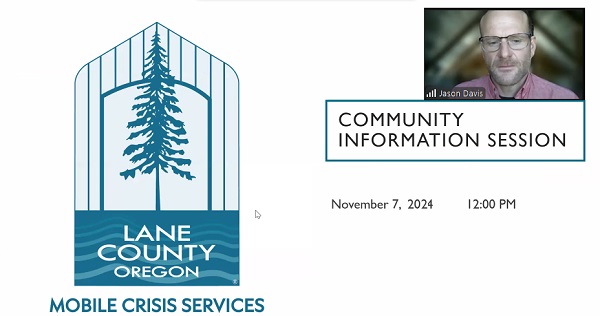Lane County hiring to expand its 988 mobile crisis services
11 min read
Presenter: Since launching its mobile crisis service in August, Lane County has been responding to behavioral crises countywide. What number do we call for the mobile crisis service?
[00:00:12] Jason Davis: Contact us either through 988 which then works through a dispatcher or the (541) 682-1001, which is our crisis line. It is up to dispatch to determine what the appropriate service is, sometimes that might be just talking to someone on a crisis line, seeking additional help, sometimes it might be a partner provider.
[00:00:30] And when we do have an individual is experiencing complex behavioral health crisis, mobile crisis will be dispatched.
[00:00:36] Little bit more information on 988 and 1001. I’m sure most of you are familiar with 988 as the federally-mandated version of 911, designed to have that sort of socialization across our country and achieve parity with physical health when it comes to having a triple-digit emergency number that is well known. The other thing that folks might not realize is that 988 is connected to a variety of different services.
[00:01:06] The 1001 is our crisis line that we stood up. Again, according to OHA requirements that needed to be in place, it does effectively the same thing with a crisis and suicide hotline, and then the ability to refer out to dispatch and dispatch can refer mobile crisis services or a partner agency.
[00:01:26] Presenter: He organized a public information session Nov. 7 to answer some of the most frequently asked questions about the new mobile crisis services.
[00:01:36] Jason Davis: We found since the launch of the service that one of our biggest hurdles to our community members is misinformation about how the service works and then what our intentions are around the service.
[00:01:48] And so I think just to clear up the air, Mobile Crisis Services of Lane County is here to add to the existing services of Lane County. We are trying to meet state mandates, yes, but also make sure that our county has the infrastructure in place to be able to respond to behavioral health crises in an effective manner and really complete our continuum of care.
[00:02:10] We’ve been through many growing pains in that process. We’re constantly trying to improve.
[00:02:14] Presenter: Jason explained the origin story behind Lane County’s Mobile Crisis Service.
[00:02:20] Jason Davis: The Oregon Health Authority made the requirement that all counties work with them to provide mobile crisis services throughout their county.
[00:02:27] In Lane County, obviously, that can be a challenge because we have a large metro area, but then pretty disparate rural communities spread over an area the size of Connecticut.
[00:02:36] Our first inclination was to look at the services that were already available in Lane County… to try and work with some of those partners and see what we could do to expand services or if there was a way to contract out services.
[00:02:48] The conclusion was that the really only viable option to meet the state’s deadline and to be able to extend these services was for Lane County to go ahead and do it. And that’s what we did. We launched in August, and since then, the service has been up and active, partially active really, because we’re still not providing 24/7 coverage.
[00:03:09] Mobile crisis services is effectively a van, either a qualified mental health professional (QMHP) or a qualified mental health associate (QMHA) and peer supports in the van that are responding to individuals who are experiencing a behavioral health crisis.
[00:03:23] This is not designed to be a police alternative. This is not designed to provide mental health support for an individual who is not in crisis. This really is zeroed in on those individuals who are truly experiencing a crisis.
[00:03:38] Presenter: Jason discussed the mental health facility planned for RiverBend.
[00:03:42] Jason Davis: You may have heard talk around the Stabilization Center that has been kind of theoretical for a number of years and just recently we have been able to land on a campus that will be adjoining the PeaceHealth inpatient behavioral health hospital, right next door to that and so that will really work hand in glove with some of these stabilization services, some of these mobile crisis services. And it will offer just that next step for individuals who are experiencing a crisis in the moment.
[00:04:11] We have access to certified mental health practitioners, meaning that, you know, that initial interaction of stabilization can go further. We can actually, to some extent, prescribe medication and really try to achieve stabilization in that moment as much as possible.
[00:04:30] And additionally, you know, we’re not just looking at that individual moment, but any kind of contributing factors that may have led to that episode of destabilization and try to wrap services around that individual.
[00:04:40] Thankfully, since this is coming from Lane County Behavioral Health, which is part of Lane County Health and Human Services, we do have the ability to try and open up services for individuals and try and meet needs that may be contributing to overall destabilization.
[00:04:56] And then of course we follow up within 72 hours of contact and trying to ensure that that individual has in fact received additional support and care beyond just that initial interaction.
[00:05:08] Presenter: A separate facility provides services for youth in crisis.
[00:05:13] Elise Gray: Riverview Center for Growth, formerly the Child Center, is the umbrella for the youth crisis response program that is funded by the county. So we are contracted through the county, but all of our staff and our services come out of Riverview.
[00:05:28] A little history. The youth crisis program has been around for about 20 years or so. It used to be run through three different agencies in the county. However, for the last two, two and a half years it’s been under the Riverview umbrella only. So it has been a pretty established program that’s been serving youth in crisis for quite a while.
[00:05:49] We do serve ages 20 and under. So if there is a call that’s coming in, say you call the 1001 number or the 988 number and it’s an 18- to 20-year-old, it’s just kind of based off of what kind of services you need. Do you have a 20-year-old that might have some developmental delays that would require more youth support or is it somebody that would be a better fit for the adult line?
[00:06:12] So we do kind of have a buffer there so that that ages 18 to 20 has a choice of which route they’d like to take as far as getting some help while they’re in crisis.
[00:06:21] We are a parent-driven program for the most part. So anytime a team responds in person, we do have a parent permission form that’s giving us permission to enter the area or the home to talk to the kiddo. It’s giving us permission to reach out to care providers that they already have, just to give them a heads-up, like, ‘Hey, we just went out on a visit on this kid.’
[00:06:43] I understand that there’s some some youth don’t have parents involved and so we can work with that. We’re not going to say no. We’ll always figure out a way to respond, whether it’s over the phone or if there needs to be a team in person. Again, we are 24/7, 365 days a year.
[00:07:03] What happens during a crisis call? We have, our team consists of a dispatcher and two mobile response teams with at least a QMHA on them. Some of our teams have a QMHP and a QMHA, but every team has at least a QMHA staff member on there.
[00:07:20] After those two mobile response teams, we also have a secure transport. If the person in crisis needs to go to the emergency department, if their age is 13 and under and we can get them a respite bed at a local agency in town, we can work with that, and we can help transport the youth to where they need to go. Again, parent and guardian consent is required for under 18. However, if there’s special circumstances we will work with that.
[00:07:46] So services we provide: suicide risk assessments, behavioral de-escalation, crisis respite. Riverview also has an intensive stabilization services services program that coexist with our crisis program. So what the intensive stabilization services is, if the youth and family aren’t connected to mental health services, then we can try to implement some services short-term to get you where you might need to go long-term. It’s eight to 12 weeks long.
Again, we’re not just cutting people off if we don’t find something for them at 12 weeks. We like to see those clients through to make sure that they’re passed off and have a warm handoff to their longer-term services. Those assessments can happen within 72 hours. These services include a therapist and a peer support.
[00:08:35] And then we have youth peer support for 13 and over and a ’Behavioral Skills Building’ staff member that can work with kids under 13. And that person can work with the parents, the child, and just kind of make a plan to help minimize the amount of crisis that’s happening in their home until we can get them somewhere long term.
[00:08:56] Who can call? Parent or guardian or provider of a youth; any kid can call for themselves. We really encourage youth to call us on their own if they’re having a hard time, if they’re feeling suicidal, if they’re feeling really angry and they don’t know if they can manage their body, whatever that may be. We really love it when the kids call themselves and just kind of talk to us. Sometimes it’s a nice outlet, but you can call if you’re a parent or guardian provider. We have schools call us, doctor’s offices, therapists, etc.
[00:09:28] The call comes into our dispatcher and oftentimes our dispatchers are able to help work something out over the phone. However, if that’s not, (1) feasible for you or (2) the kid just is not choosing to make safe choices or not feeling like they can calm down, then we will send a two-person team to evaluate and try to help de-escalate the situation.
[00:09:52] We respond to Lane County. So: Florence, Oakridge, Cottage Grove, Eugene, Springfield, all of Lane County. We do provide services, crisis services to all of those areas. Again, if you’re in Florence or Oakridge, it is probably going to be about an hour response time. But as far as locally, Eugene, Springfield, even Creswell, Cottage Grove, it’s about 15 to 45 minutes for a response time.
[00:10:17] Jason Davis: Thank you, Elise. And as well—really quick I will highlight the fact of what Elise said actually reminded me of—it is that our program is voluntary. And so that has been something that some feedback or actually confusion that we’ve received from the community. Again, this is not a police alternative. This is not something that is sent in and the results are statutory or required. This is really about working with the individual to achieve the best outcomes with their consent.
[00:10:46] Presenter: Cottage Grove Police Chief Cory Chase asked about service in South Lane.
[00:10:52] Jason Davis: We have the capability right now to dispatch to Cottage Grove. We do not, however, have a van embedded within the community to be able to respond in that way where we would be able to cut those response times down to an effective rate.
[00:11:07] So the primary reason why we don’t have that van embedded down there right now, again, is staff. We just don’t have the, especially with the QMHAs and the QMHPs, we have not hired enough individuals to be able to expand throughout the county. Again, our goal is to have six vans spread throughout the county. One would certainly be in South Lane.
[00:11:28] And the barriers that we are currently facing are probably the barriers that most of us as organizations are facing, which is staffing. And we just aren’t staffed to that level where we have those six vans placed throughout the county able to, you know, be in Oakridge, Cottage Grove, Junction City, Veneta, and some of those communities, that is the end goal.
[00:11:49] And can’t, I don’t have a crystal ball on when those applications will roll in and those folks will get hired, but as soon as those bodies are in place and we have those folks trained up, that is our mission. I do also know that the timeline was floated for 24 /7, which also coincides with that expansion, that the goal was around the new year. However, I don’t think anybody should take that as a hard-and-fast set-in-stone thing because, again, it, has to do with our ability to recruit and retain talent and provide that.
[00:12:22] So I think the best answer is ASAP (as soon as possible).
[00:12:26] Presenter: Nat asked: What about CAHOOTS?
[00:12:29] Jason Davis: Yeah, so CAHOOTS obviously has existed in the Eugene area for way longer, decades longer than Mobile Crisis Services and has really provided that template by which pretty much all of this is based on. And so what, we see Mobile Crisis Services as a complement to the services they provide.
[00:12:50] And as they expand, contract, whatever they do as an organization, we want to support that because, again, we need all the services we can get right. There isn’t room to have one or the other. So, I think our mission right now is just to try and look at creative ways to make sure that all the services can operate in tandem and that regulations and restrictions that we communicate the difficulties of those and really look at the pragmatic solutions that currently are barriers to try to diminish that with the help of the Oregon Health Authority.
[00:13:30] And I think Oregon Health Authority has been very sympathetic in how do we operate multiple services under an umbrella within a given geographical area. And so that relationship is evolving. And I certainly won’t speak on behalf of CAHOOTS or on behalf of White Bird, but I can tell you that our intent is really to try to grow services as much as possible. However that looks really isn’t the issue, what the issue is, do our people have the support they need in a timely manner? Are we building that infrastructure? And that’s really what we come back to at the end of the day on all of us.
[00:14:07] Presenter: He closed with a prediction, and a request. He asks you to help improve Lane County Mobile Crisis Services.
[00:14:14] Jason Davis: This is going to be an evolution. What Mobile Crisis Services looks like today is likely going to be different than what it looks like in six months, a year.
[00:14:22] I do encourage you to check out those FAQs on our website, read through them, and again, have a question or something on there that isn’t answered, please send that to us so we can be responsive and get that up there. And again, if there’s any suggestions you have on how we can tackle misinformation, strengthen relationships, and really carry the conversation out to the people who need it, please, please, please let us know.
[00:14:45] And we will get back with you on when we have more information sessions. Thank you so much.
[00:14:50] Presenter: Learn more about Mobile Crisis Services of Lane County at their website.



